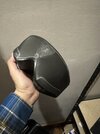FuriousFido
New Member
This is my first thread so I am new to the documentation portion of cosplay, and first time making a helmet.
The helmet I am making is a Helldivers 2 B-01 Helmet, the default helmet used in the game when you start out but my take on it will be a mix of Helldivers with ODST themed Paint scheme and decals. This helmet will be used as a mashup with my (unfinished at the moment) Sean Bradley ODST kit which will use the same colors.
The helmet files are provided by GalacticArmory through their patreon, the files were scaled by default to a 24" head size. The dome piece had to be split to allow for bed size, the prints took between 3-11 hours. The longest being 11 hours 24 minutes for the Visor Buck. I wanted it to take its time slowed down and decreased layer height to provide a smoother surface for when the visor will be vacuum formed by myself.
Printer- Bambu X1 Carbon
Material- Hatchbox PLA (black)
Paint- Rustoleum Black for the main sections, Rustoleum Chrome for the vents, and detail paint like the stripes will be Ford Engine Green. This is to tie into another hobby of working on a 1930 Ford Model A truck with my dad and brother and also green is our favorite color. We plan to use this same green for detail coloring in our ODST kits.
I plan to use the ODST emblem in place of the Helldivers skull emblem on the sides of the helmet, if I am to make a cape I will do the same for the emblem on that.
I will try to keep the thread updated and motivation high, cannot wait to show others and see the project finished.





The helmet I am making is a Helldivers 2 B-01 Helmet, the default helmet used in the game when you start out but my take on it will be a mix of Helldivers with ODST themed Paint scheme and decals. This helmet will be used as a mashup with my (unfinished at the moment) Sean Bradley ODST kit which will use the same colors.
The helmet files are provided by GalacticArmory through their patreon, the files were scaled by default to a 24" head size. The dome piece had to be split to allow for bed size, the prints took between 3-11 hours. The longest being 11 hours 24 minutes for the Visor Buck. I wanted it to take its time slowed down and decreased layer height to provide a smoother surface for when the visor will be vacuum formed by myself.
Printer- Bambu X1 Carbon
Material- Hatchbox PLA (black)
Paint- Rustoleum Black for the main sections, Rustoleum Chrome for the vents, and detail paint like the stripes will be Ford Engine Green. This is to tie into another hobby of working on a 1930 Ford Model A truck with my dad and brother and also green is our favorite color. We plan to use this same green for detail coloring in our ODST kits.
I plan to use the ODST emblem in place of the Helldivers skull emblem on the sides of the helmet, if I am to make a cape I will do the same for the emblem on that.
I will try to keep the thread updated and motivation high, cannot wait to show others and see the project finished.

